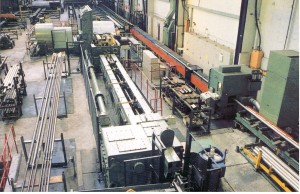Major application grades of Nickel-Chromium-Molybdenum alloys
Alloys in this group are Inconel 625, Hastelloy C276, Hastelloy C4 and C22. They are used for enhanced corrosion resistance in the oxidizing conditions.
Inconel 625
It is used in applications where strength and corrosion resistance are needed. It attains outstanding fatigue strength and supreme strength and toughness at temperatures from cryogenic to 2000oF. Columbium and tantalum stabilization makes it fit for corrosion service in the as-welded condition. It offers supreme resistance to chloride stress corrosion cracking.
Inconel 625 offers supreme resistance to phosphoric acid solutions, comprising of commercial grades of acids such as fluorides, sulphates and chlorides in the production of superphosphoric acid.
Alloy 625 also provides good resistance to aqueous solutions in diverse applications such as organic acids, sulfuric acid and hydrochloric acid at temperatures below 150oF. It resists corrosion caused by mixtures of nitric-hydrofluoric acids in conditions where stainless steels fail to perform.
Hastelloy C276
Alloy C276 is a low carbon-silicon grade of Hastelloy C and hence can be used in the as-welded form in various applications. Hastelloy C276 is highly versatile as it offers good resistance to both oxidizing and reducing media, including conditions with halogen ion contamination. When handling acid chloride salts, pitting and crevice corrosion resistance by Hastelloy C276 make it a popular application material.
Hastelloy C276 offers outstanding corrosion resistance to diverse chemical process materials as well as highly oxidizing neutral and acid chlorides, solvents, chlorine, formic and acetic acids and acetic anhydride. It also prevents corrosion like wet chlorine gas, hypochlorites and chlorine solutions.
Outstanding corrosion resistance is attained in the presence of phosphoric acid at all temperatures below the boiling temperature of phosphoric acid when the concentrations are below 65%. Corrosion rates of below 5 mpy were evaluated. For concentrations 65% to 85%, Hastelloy C276 shows similar corrosion rates, except for temperatures up to boiling point where corrosion rates can be erratic and may touch 25 mpy limit.
Hastelloy C4
However Hastelloy C276 resists carbide precipitation, precipitation of the intermediate micro phase can occur. Hastelloy C4 reduces this type of precipitation. Chemistry of Hastelloy C4 and C276 differs by iron and tungsten. General corrosion resistance of both alloys is similar. In the vigorous reducing conditions like hydrochloric acid, Hastelloy C4 offers nominally higher corrosion resistance rates as compare to C276 although in the oxidizing conditions, the results are opposite.
Hastelloy C4 can be used in temperatures in the normal sensitizing limit of 1022oF to 1994oF for the long periods without experiencing vigorous corrosion. Such exposure can be caused by welding, thermo-mechanical processing like hot forming or rolling operations, stress relief or normalizing treatments or operation of process system in the sensitizing limit.
Hastelloy C22
This Hastelloy grade is made to enhance on the shortcomings of Hastelloy C276 and C4. This alloy is limited in its applications in oxidizing conditions comprising of low magnitudes of halides and in conditions comprising of nitric acid. Additionally, the heat stability of alloy is inadequate to be cast. However Hastelloy C24 has higher heat stability, it fails to offer corrosion resistance to chloride comprising conditions.
Hastelloy C22 overcomes these drawbacks. It is not just superior in oxidizing conditions comprising of nitric acid, however it also has enhanced pitting resistance over that of Hastelloy C276.


 +1 206 890 7337
+1 206 890 7337 sales2@super-metals.com
sales2@super-metals.com